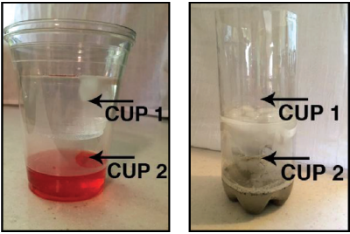Introduction
Can you recycle water? Is it possible to separate pure water from polluted water? Find out in the following investigation, where you create your very own water system!
Materials
- 2 different-sized transparent cups or plastic bottles (recycled if possible!)
Note: One cup must fit on top of the other so that the top cup goes only part-way into the bottom one. You can make cups by cutting the tops off two empty plastic beverage bottles of the same shape. Colorless cups or bottles work best. - hot tap water (from a faucet)
- “model pollutant” (choose one or more substances such as food coloring, salt, cooking oil, crushed pieces of candy, or sand)
- ice cubes or crushed ice
- cold water
Safety Suggestions
- Safety goggles required
- Protective clothing suggested
- Caution: hot liquids!
- Do not eat or drink any of the materials used in this activity
- Thoroughly wash hands after this activity
- Use hot water from the faucet. Do not use boiling water, which is too hot and softens some plastics. Get an adult to assist you.
Note: Follow Milli’s Safety Tips found in this issue of Celebrating Chemistry.
Procedures
Download and Print Activity

- Set up your system by placing cup 1 on top of cup 2. Make sure the bottom surface of cup 1 is well above the expected level of water in cup 2.
- Remove cup 1.
- Add hot tap water to cup 2 to a height of about 2 cm.
- Add a small amount of your chosen pollutant to cup 2.
- Place ice and cold water in cup 1.
- Place cup 1 on top of cup 2.
- Record your observations in a table three times — at the beginning, after 10 minutes, and after 30 minutes.
- Consider repeating your experiment with another “pollutant.” Predict how your results will change. What happened?
Observations

What is on the bottom of the cup 1? Is there evidence of the added “pollutant” on the bottom of the cup? How can you tell? Can you see or feel any evidence of the pollutant on the outside of cup 1? What if you added a different color of food coloring to the ice water in the top cup? How might that change the experiment?
How does it work? Where's the chemistry?
Have you heard of the water cycle? In the water cycle, the sun heats liquid water and turns it into a gas called water vapor. This process is called evaporation. When the water evaporates, it leaves everything else in it behind. When the water vapor cools, it becomes liquid water again. This process is condensation. There’s another article in this issue of Celebrating Chemistry about the water cycle. Be sure to read it!
In your experiment, water vapor rising from the hot water in cup 2 contacted the cold bottom of cup 1. You observed condensation on the bottom surface of cup 1 as drops of pure water.
The liquid or solid “pollutants” you added to cup 2 did not end up on the bottom of cup 1. Why not? The pollutants need more heat to evaporate than water needs to form water vapor, and so they are left behind. The water cycle recycles water around the earth through evaporation and condensation.
More Ideas
By testing different “pollutants,” you can investigate the claim that pure water can be separated from “polluted water” by turning into water vapor and condensing as the water on the bottom outside of the top bottle. Try the activity with food coloring and water, sand and water, or other combinations.
Download this activity as a printable PDF:
(Re)Cycling Water (PDF) | (Re)Ciclar el Agua (PDF)
Adapted from: Teaching Physical Science through Children’s Literature, by Susan E. Gertz, Dwight Portman, and Mickey Sarquis, published by Terrific Science Press with funding from the National Science Foundation, 1996. pp 67-76.
Susan Hershberger, Ph.D. is Director of the Center for Chemistry Education at Miami University in Oxford, Ohio.


